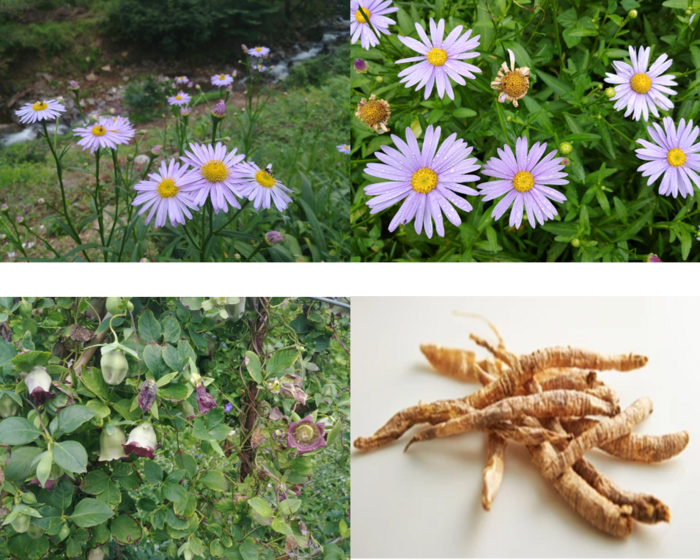COVID blocking antiviral compounds discovered within native plants in South Korea
Two saponins were identified to be highly effective in blocking the ability of SARS-CoV-2 variants including Omicron to enter the cells.

[Nov 26, 2022: William Suh, Institute for Basic Science]
Aster koraiensis and Bottom) Codonopsis lanceolata, which are native plants in South Korea. (Credit: Institute for Basic Science)
Codonopsis lanceolata, more commonly referred to as “deodeok”, is used as a medicinal herb in South Korea. It is cultivated in large quantities and has been an integral part of Korean cuisine across history. Aster koraiensis, or Korean starwort, is a common flower that resembles a daisy, which is only found in the Korean peninsula. What can these two different types of plants have in common?
A team of researchers led by Director C. Justin LEE from the Life Science Institute (Center for Cognition and Sociality) within the Institute for Basic Science (IBS), South Korea, recently announced the discovery of new antiviral compounds derived from these two Korean native plants. The researchers discovered that the saponins found within these plants were particularly effective at inhibiting SARS-CoV-2 infection by blocking membrane fusion, which allows the viruses to invade the host cells. These findings were published in Antiviral Research and Antimicrobial Agents and Chemotherapy.
Coronaviruses are known to enter human cells via endosomes or fusion at the plasma membranes. In both of these two pathways, a process known as “membrane fusion” must occur between the coronavirus envelope and the cell membrane.
The research team revealed that two saponins (astersaponin I and lansemaside A) found within the two beforementioned plants are capable of blocking this fusion of the membrane between the coronavirus and human cells, thereby effectively blocking all the ways that the virus can infect its host.
Related Stories:
The research team first made a SARS-CoV-2 infection model using human lung cells overexpressing ACE2 receptor protein and a pseudovirus that expresses the viral spike protein on its surface, which can be used in the relatively less restrictive biosafety level 2 research facility.
The cells were treated with astersaponin I and lansemaside A to test the compounds’ inhibitory effect on virus infection. Both saponins were found to have an IC50 value (half maximal inhibitory concentration) of 2 μM, indicating that they were highly effective at stopping the coronavirus from entering the cell.
The same results were confirmed in subsequent experiments using actual authentic coronaviruses, and infection was suppressed with almost the same efficiency. More importantly, the inhibitory effect was identical for all SARS-CoV-2 variants, such as the Omicron.
Astersaponin I prevents COVID-19 infection in a dose-dependent manner, with an IC50 value of 2 μM. The saponin worked equally as well against all variants of SARS-CoV-2, due to its ability to block membrane fusion. (Credit: IBS)
Astersaponin I and lansemaside A are triterpenoid saponins. They both have central ringed hydrocarbon (or core) structures very similar to that of cholesterol, which is the main component of cell membranes. in addition to a polysaccharide chain attached to one side. The central part of these saponins readily binds to the cell membrane thanks to their similarity to cholesterol.
When the molecule penetrates into the cell membrane, the long sugar chain on protrudes out of the cell membrane. It is believed that this protruding sugar is what blocks the cell membrane from fusing with the coronavirus envelope.
Coronaviruses enter cells through membrane fusion between the virus envelope and cell membrane. When cells expressing coronavirus spike protein (green) are cultivated with human lung cells (red), membrane fusion followed by fusion between the two cells can be observed. Lansemaside A inhibits this membrane fusion, thereby confirming that its mechanism is based on blocking membrane fusion. (Credit: IBS)
SARS-CoV-2 variants such as Omicron are more infectious than original onedue to the mutations in the spike protein, which enhances their binding affinity with the ACE2 cell receptor. However, no matter how much the SARS-CoV-2 variants to increase its affinity, it will be unable to enter the cell if the whole membrane fusion process, which occurs after viral binding to the receptor, is blocked. That is, the membrane fusion inhibitor can effectively prevent the infection of SARS-CoV-2 variants regardless of the their affinity to human cell receptor.
In the past, the IBS team worked jointly with Dr. KIM Seungtaek from Korea Pasteur Institute and discovered another natural triterpenoid saponin called platycotin D from the balloon flower. This saponin was also found to be effective against SARS-CoV-2 infection. This research was published in the journal Experimental & Molecular Medicine.
Astersaponin I, lancemaside A, and platycodin D are triterpenoid saponins with central ringed hydrocarbon structures similar to that of cholesterol. This allows one side of the saponin to become readily embedded within the cell membrane. It is believed that the polysaccharide chain protruding from the cell membrane is what prevents membrane fusion from occurring. (Credit: IBS)
Armed with this knowledge, the IBS researchers in collaboration with Prof. HAN Sunkyu’s team from Korea Advanced Institute for Science and Technology (KAIST) explored the creation of synthetic saponins with potentially even more powerful effects.
The joint team made and tested a dozen synthetic saponins possessing different polysaccharide chains with varying lengths and types of sugars. One of these saponins was found to have up to twice higher activity as that of platycodin D. This research was published in the 2022 October issue of the journal Bioorganic Chemistry.
12 different synthetic saponins were synthesized using Platycodin D as the base. Right) One of the synthetic saponins showed twice higher ability to inhibit SARS-CoV-2 infection. (Credit: IBS)
Director C. Justin LEE stated, “Natural saponins contained in these plants are major constituents in many foods and herbal medicines that are readily accessible in everyday life. When ingested, it can be delivered at high concentrations to the epithelial cells of the upper respiratory tract, which means it can be effective in an asymptomatic or early stage of COVID-19 infection.” He added, “While their effects have been confirmed only in vitro at the moment, clinical trials may be possible in the future if positive results are obtained in animal tests.”
Senior Researcher KIM Taeyoung from the IBS said, “Historically, many important drugs such as penicillin, aspirin, or the antimalarial drug artemisinin have been derived from natural organisms. As these saponins’ mechanism of action relies on inhibiting membrane fusion, it may even be possible to develop broad-spectrum antiviral drugs based on this principle.”
Note: Materials provided above by Institute for Basic Science. Content may be edited for style and length.
Like these kind of feel good stories? Get the Brighter Side of News' newsletter.
Joshua Shavit
Science & Technology Writer | AI and Robotics Reporter
Joshua Shavit is a Los Angeles-based science and technology writer with a passion for exploring the breakthroughs shaping the future. As a contributor to The Brighter Side of News, he focuses on positive and transformative advancements in AI, technology, physics, engineering, robotics and space science. Joshua is currently working towards a Bachelor of Science in Business Administration at the University of California, Berkeley. He combines his academic background with a talent for storytelling, making complex scientific discoveries engaging and accessible. His work highlights the innovators behind the ideas, bringing readers closer to the people driving progress.



